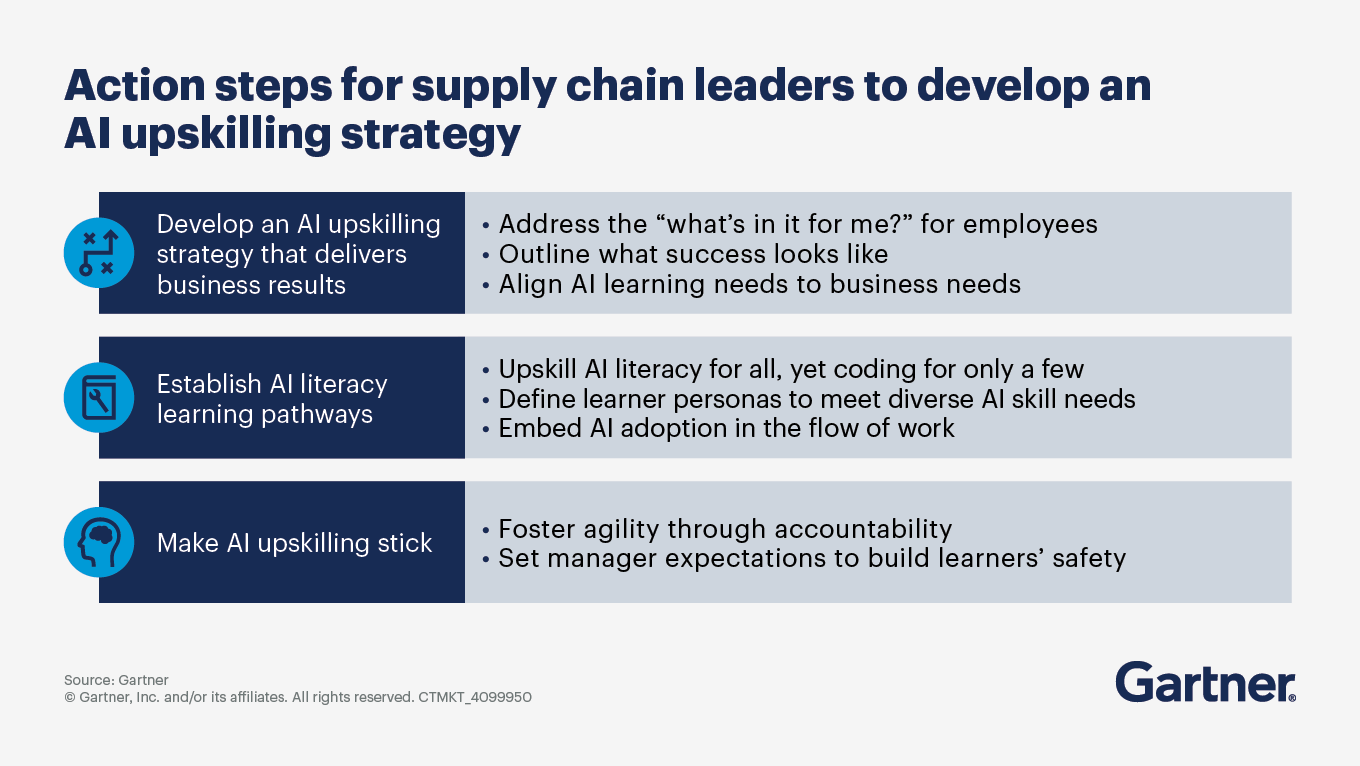The future of operational excellence depends on AI-ready talent. By upskilling their teams, supply chain leaders secure resilience and accelerate growth.
- Gartner client? Log in for personalized search results.
Unlock the Full Potential of Supply Chain Talent With AI Upskilling
By Mel Mohamednur | October 24, 2025
To excel, supply chain talent must make the shift from AI openness to AI action
In the 2025 Gartner AI Adoption in Supply Chain Survey, supply chain workers whose organizations have deployed AI in the supply chain in the past year reveal that while 94% of respondents are open to using AI, only 36% know how to integrate it into their workflows.
While the vision for AI in the supply chain is vast, the reality is that employees are unlikely to learn AI on their own. Supply chain leaders who proactively address the AI skills gap will drive greater efficiency, innovation and business results.
See Gartner insights in action at our supply chain conferences and events.
Build an AI-ready workforce to ensure supply chain’s ability to compete and adapt
Establishing AI literacy throughout the supply chain gives your workforce a shared language for collaboration and excellence. It is important to create an AI upskilling environment that moves the needle on business performance by taking the following actions:
Build an AI upskilling strategy that delivers business results
Address the “What’s in it for me?” for employees. Communicate that AI upskilling isn’t just an option, it’s a necessity for those who want to remain competitive and future-proof their careers. The opportunity costs of inaction are twofold: The enterprise risks being outpaced by competition, missing out on efficiency gains and struggling to sustain performance. Employees risk missing out on career advancement, losing relevance and jeopardizing both individual and organizational success.
Define what success looks like. Help your organization lean into change by focusing on outcomes, such as increased productivity, internal mobility, retention and employee engagement. Then tie these outcomes to business strategy and supply chain goals..
Align AI learning with business needs to achieve the selected outcomes. Bring clarity and direction to the AI upskilling journey and pressure-test your strategic alignment by asking the following:
Does my AI upskilling strategy align seamlessly with overall business goals?
Will AI upskilling advance our supply chain goals?
Does the strategy emphasize both the technical skills and the soft skills needed to grow and innovate?
Establish AI literacy learning pathways
AI upskilling helps employees understand what AI is, how it works at a high level and how it impacts their work and industry. An effective AI learning pathway should accomplish the following:
Upskill AI literacy for all, coding for a few. At a high level, successful AI upskilling means employees can use AI effectively, safely and adaptively in their jobs. Only a small percentage of the workforce (data scientists, data engineers or advanced AI users) will need to learn coding or building AI agents. The rest will simply need to know how to work alongside AI tools (such as chatbots, automation or AI-driven analytics), how AI can impact workflow or decision making, and how to interpret AI outputs with confidence and ease.
Define learner personas to meet various AI skill needs. Once you’ve determined the levels of upskilling needed for various learners, create personas that address specific motivations, skill levels, challenges and learning styles. Then tailor AI training to these personas for real impact. For example:
- An “AI explorer” might be a frontline worker who needs to learn the basics of AI to stay relevant and feel confident using AI tools in their day-to-day role.
An “AI strategist” might be a leader of supply chain AI transformation initiatives who needs training to develop and champion a vision for AI adoption.
Embed AI adoption in workflows. Knowledge alone doesn’t create skills or drive strong performance. Real improvement comes from practice and hands-on experience. Prioritize opportunities for employees to apply their newfound AI skills on the job — for example, by encouraging them to use GenAI to draft performance review summaries or to share AI-generated insights from meeting notes.
Make AI upskilling stick
Investing in AI isn’t just a “shift” but rather a “lift” in changing ways of working. Change doesn’t happen overnight — but in today’s unpredictable supply chain environment, agility is essential. The following are some ways to build long-term talent agility and help your organization thrive.
Foster agility through accountability. Leaders who consistently demonstrate desired behaviors turn abstract change initiatives into visible, credible actions. This builds trust, sets the tone and makes it easier for everyone to follow — making changes stick.
Leaders could also model accountability by sharing personal experiences using AI tools. This could look like AI upskilling in personal development plans, and actively participating in learning events or pilot programs alongside teams.
Set manager expectations to build learners’ psychological safety. Leaders must buy into the vision of AI upskilling to ensure their employees will take it seriously. Equip managers appropriately by giving them the resources and tools they need to:Prioritize when there is a time conflict
Manage up and level-set expectations
Measure skills proficiency and provide actionable feedback
Support individualized learning paths to meet diverse needs
AI upskilling FAQs
What are the advantages of AI upskilling in the supply chain?
AI upskilling in the supply chain helps employees and leaders gain the knowledge and skills to use AI in their work. This allows them to improve operations, solve problems and make better decisions with the help of AI. Success could look like employees using AI-driven insights for decision making or using AI to solve business problems.
What are the key components of AI literacy?
AI literacy is the ability to effectively and responsibly use AI in a business, societal and role-based context. It includes understanding the fundamentals of AI, technology and applications; analytical and algorithmic methods at a high level; data and knowledge sources; risks; and ethical considerations.
Attend a Conference
Join Gartner experts and your peers to accelerate growth
Join the world's most important gathering of CSCOs and supply chain leaders, along with Gartner experts, to collectively rethink supply chains for future success.
Gartner Supply Chain Symposium/Xpo™
Orlando, FL

Drive stronger performance on your mission-critical priorities.
